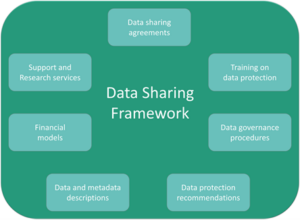Last modified on April 25, 2024
From Strategy to Action: Advancing Data Sharing in European CCAM Initiatives
In 2020, European Commission stated that there is problem of insufficient data sharing as part of ” the Problem” in its European strategy for data, where it was stated that the value of collected data was far from realized. Being early in digitalisation, this could be interpreted as a clear message to the automotive industry. However, I would state that data sharing in European research project started earlier than that (e.g., UDRIVE or L3Pilot projects), and taking further steps since then.
Data sharing in CCAM is about sharing data with the objective to accelerate development of safe, reliable, and efficient automated vehicles on European roads. In this multidimensional challenge, there is need for sharing different categories of data, between different stakeholders.
The Data Sharing Framework (DSF) published in 2016 mainly considered topics related to field operational tests of naturalistic driving. The framework was divided into seven sections, comprising best practises and lessons learned from many research projects. As an example, the content of different agreements in these projects could eliminate re-using some important datasets, and countermeasures were proposed. Large emphasis was put in data description and data protection, both establishing trust between the data provider or owner, and data user.

Two different approaches of data sharing were proposed in the first version of the DSF: transferring data between the two stakeholders (online or using an intermediary state (e.g., a data disk) or on-site/remote desktop (accessing the data within the data provider’s environment). In 2010, a third option was demonstrated: federated data sharing. The earlier implementations came from the Fraunhofer initiative Industrial Data Spaces Association (later International Data Spaces Association (IDSA)). This concept got massive support when the Germany and France in 2021 initiated the GAIA-X collaboration project, with close links to the IDSA. GAIA-X is supported by hundreds of large organisations, defining the specification for federated data sharing.

In the FAME project, we’ve updated the DSF into a CCAM DSF version 2 with the concept of federated sharing, adding material to most sections, also clarifying the scope of the framework. This major update includes a complete revision of the document, keeping up with the rapid development in CCAM related topics.
The implementation of federated data sharing is called a data space. The data space is a digital federated infrastructure, where stakeholders agree on common terms and principles for data access, interfaces, formats, description, taxonomy, that have the potential in unlocking relevant data for CCAM R&D. Trust is established by a set of rules when onboarding the data space and governance mechanisms. All assets are described in a Data Catalogue. A Data Provider define data access and rules per Data Consumer in what is called a Connector, with full control on who has access to what data. This small component serves as an interface to the internal databases/infrastructure of the data provider. The terms and conditions are defined in a contract between the actors.
The next step of the FAME project is to realize the concepts of federated data sharing described in the DSF, by demonstrating the capabilities in a CCAM Test Data Space. As part of this work, different use cases will be investigated, getting an understanding of in which use cases this concept would be of most use: 1) digital twin representation of driving scenarios or edge cases for development or validation, and performance and safety assessment, 2) ADS monitoring (accident and/or incidents), 3) AI model training, using large databases of images or video, 4) sharing high level KPIs from projects or countries, 5) large project consortia or initiatives, collecting harmonized data, and applying common scripts.

There are many related activities ongoing, and the project will investigate the potential in connecting different data spaces. The most obvious is the European Mobility Data Space deployment project, but there are also topics from SUNRISE project (and its continuation) to explore.
It is a true challenge to keep up with the rapid development in the field (both from IT perspective, but also in CCAM), and to onboard relevant CCAM projects to try-out these concepts. However, we aim in having a sandbox environment to explore the technology in early fall. As a coordination action, we hope to involve many stakeholders in taking use of this technology and to increase data sharing in CCAM. We are welcoming any project within CCAM to discuss potential collaboration, or just demonstrating the concept.
Written by, Erik Svanberg, FAME work package leader, SAFER vehicle and traffic safety centre Chalmers University of Technology.


